Question 1:
Draw a labelled diagram of human female reproductive system.
Answer:
Female reproductive system of human
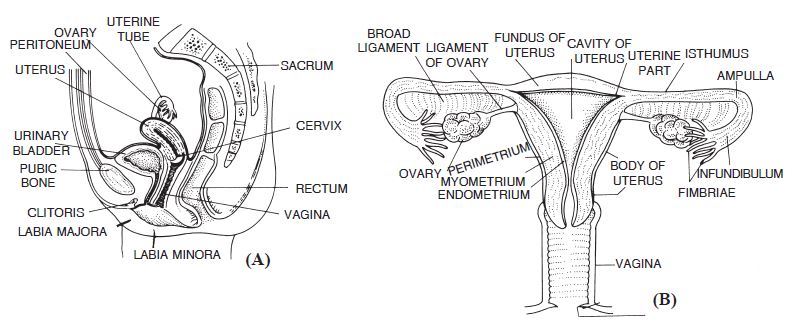
Question 2:
The process of release of ovum from a mature follicle is called ............ .
Answer:
ovulation
Question 3:
Ovulation is induced by a hormone called ............ .
Answer:
luteinising hormone (LH)
Question 4:
The fusion of male and female gametes is called ............ .
Answer:
fertilisation
Question 5:
Fertilization takes place ............ .
Answer:
ampulla of fallopian tube
Question 6:
Zygote divides to form ............ which is implanted in uterus.
Answer:
blastocyst
Question 7:
The structure which provides vascular connection between foetus and uterus is called ..... .
Answer:
placenta
Question 8:
Write two major functions each of testis and ovary.
Answer:
Functions of Testis.
(1) Production of sperms and
(2) Secretion of male sex hormones, androgens (e.g. testosterone).
Functions of Ovary.
(1) Production of ova and
(2) Secretion of female sex hormones, e.g. oestrogens, progesterone.
Question 9:
Describe the structure of seminiferous tubule.
Answer:
Seminiferous tubules. Each seminiferous tubule is lined by germinal epithelium. Majority of
cells in this epithelium are cuboidal spermatogenic cells but a few are large, pyramidal,
supporting Sertoli or nurse cells. The cuboidal cells, by mitotic divisions, produce
spermatogonia into the lumen of the seminiferous tubule. The spermatogonia grow into primary
spermatocytes, which undergo meiosis, producing haploid cells, first secondary spermatocytes
and then spermatids. The latter metamorphose into spermatozoa. Differentiation of
spermatozoa from the spermatogonia is called spermatogenesis.
The spermatozoa are nourished during development by nurse cells. Mature spermatozoa lie free
in the cavity of the seminiferous tubules. Scattered in connective tissue are Leydig’s cells
which secretes a hormone called testosterone.
Question 10:
What is spermatogenesis ? Briefly describe the process of sper-matogenesis.
Answer:
Spermatogenesis. 1. The process of sperm formation from the sperm mother cells of testis
(male gonad) is called spermatogenesis.
2. It starts at puberty (14-16 years).
A. Multiplicative phase
3. The epithelial cells present on the inner wall of seminiferous tubule multiply by mitotic
division to form large number of spermatogonia (2N)
4. Some of the spermatogonia serve as stem cells for spermatogenic lineage.
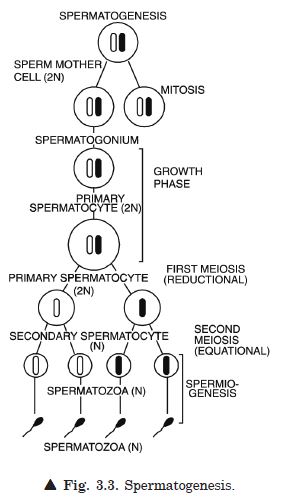
5. Other spermatogonia function as progenitor cells
or the precursors of spermatozoa.
B. Growth phase
6. Some of spermatogonia (2N) undergo changes by accumulating food materials and grow almost
double in size and become the primary spermatocytes (N).
C. Maturation phase. Each primary spermatocyte undergoes the first meiotic division and forms
two haploid secondary spermatocytes. (N)
7. The secondary spermatocytes undergo the second meiotic division leading to the formation of
four equal sized, haploid spermatids (N).
D. Spermiogenesis or Spermiation
8. The spermatids are transformed into spermatozoa by the process of spermiogenesis.
9. The sperm heads become embedded in the Sertoli cells and are ultimately released from the
seminiferous tubules by the process of spermiation.
10. The spermatogenesis is under the control of follicle stimulating hormone (FSH) secreted by
anterior lobe of pituitary.
Question 11:
Give a schematic view of spermatogenesis in human.
Answer:
Spermatogenesis. 1. The process of sperm formation from the sperm mother cells of testis
(male gonad) is called spermatogenesis.
2. It starts at puberty (14-16 years).
A. Multiplicative phase
3. The epithelial cells present on the inner wall of seminiferous tubule multiply by mitotic
division to form large number of spermatogonia (2N)
4. Some of the spermatogonia serve as stem cells for spermatogenic lineage.

5. 5. Other spermatogonia function as progenitor cells
or the precursors of spermatozoa.
B. Growth phase
6. Some of spermatogonia (2N) undergo changes by accumulating food materials and grow almost
double in size and become the primary spermatocytes (N).
C. Maturation phase. Each primary spermatocyte undergoes the first meiotic division and forms
two haploid secondary spermatocytes. (N)
7. The secondary spermatocytes undergo the second meiotic division leading to the formation of
four equal sized, haploid spermatids (N).
D. Spermiogenesis or Spermiation
8. The spermatids are transformed into spermatozoa by the process of spermiogenesis.
9. The sperm heads become embedded in the Sertoli cells and are ultimately released from the
seminiferous tubules by the process of spermiation.
10. The spermatogenesis is under the control of follicle stimulating hormone (FSH) secreted by
anterior lobe of pituitary.
Question 12:
Name the hormones involved in regulation of spermatogenesis.
Answer:
GnRH, LH, FSH, Androgen Binding Protein (ABP), Inhibin, androgens.
Question 13:
Define spermiogenesis and spermiation.
Answer:
Spermiogenesis. It is a process is which spermatids are transformed into
spermatozoa (sperms).
Spermiation. After spermiogenesis, sperm heads become embedded in the
Sertoli cells and are finally released from the seminiferous tubules by the process called
spermiation.
Question 14:
Draw a mammalian sperm and label its four major parts.
Answer:
Structure of a mammalian sperm (Fig. 3.4.)
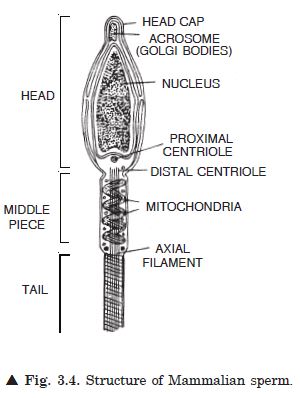
Question 15:
Which are major components of seminal plasma?
Answer:
Fructose, Calcium and some specific enzymes.
Question 16:
What are the major functions of male accessory ducts and glands?
Answer:
Functions accessory ducts and glands
1. The male accessory ducts include rete-testis, vasa efferentia, epididymis and vasa
deferentia.
2. These ducts store and transport the sperms from the testis to outside through
urethra.
3. The male accessory glands include paired seminal vesicles, a prostate and paired
bulbo-urethral glands.
4. Secretion of these glands constitute the seminal plasma, which is rich in fructose,
calcium and certain enzymes.
5. The secretion of bulbo-urethral glands helps also in the lubrication of the penis.
Question 17:
Draw a labelled diagram of section through ovary showing various stages of follicles growing in it.
Answer:
T.S of Ovary
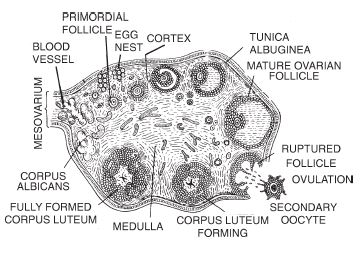
Question 18:
Briefly describe the process of oogenesis.
Answer:
Oogenesis. 1. The phenomenon of formation of haploid ovum (egg) from the diploid egg mother
cell of ovary (female gonad) is called oogenesis.
2. Oogenesis is initiated during embryonic development in a female foetus. It occurs in
three phases i.e. multiplication, growth and maturation.
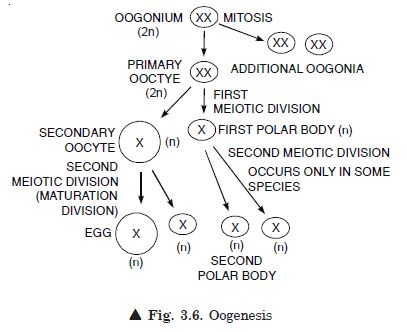
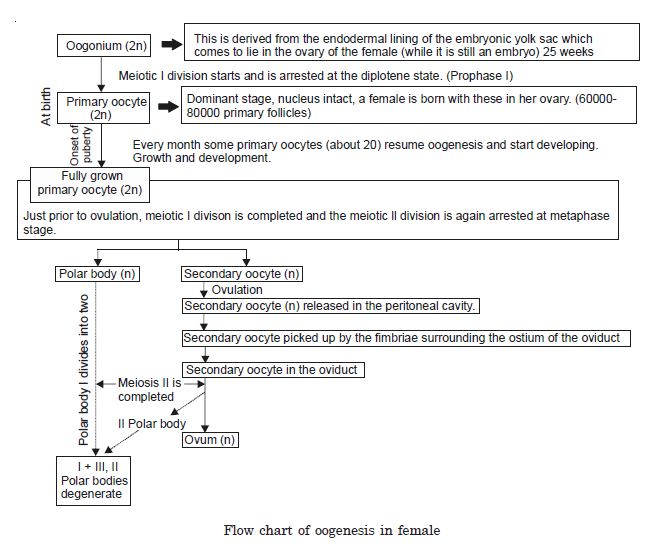
Question 19:
Give a schematic representation of oogenesis in humans. Mention the number of chromosomes at each stage. Correlate the life phases of the individual with the stages of the process.
Answer:
Oogenesis. 1. The phenomenon of formation of haploid ovum (egg) from the diploid egg mother
cell of ovary (female gonad) is called oogenesis.
2. Oogenesis is initiated during embryonic development in a female foetus. It occurs in
three phases i.e. multiplication, growth and maturation.


Question 20:
When and where are primary oocytes formed in a human female? Trace the development of these oocytes till ovulation (in menst- rual cycle). How do gonadotropins influence this developmental process?
Answer:
Oogenesis. 1. The phenomenon of formation of haploid ovum (egg) from the diploid egg mother
cell of ovary (female gonad) is called oogenesis.
2. Oogenesis is initiated during embryonic development in a female foetus. It occurs in
three phases i.e. multiplication, growth and maturation.


Question 21:
Draw a labelled diagram of Graafian follicle.
Answer:
Graafian follicle (Fig. 3.7)
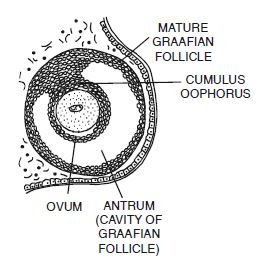
Question 22:
Name the functions of the following:
(a) corpus luteum (b) endometrium
(c) acrosome (d) sperm tail (e) fimbriae.
Answer:
(a) Functions of Corpus luteum
1. It secretes small amount of estradiol hormone and significant amount of progesterone.
2. It also secretes relaxin hormone.
(b) Functions of endometrium. It is an internal layer of uterus.
1. It undergoes cyclic changes during menstrual cycle.
2. It provides pits for implantation of blastocyst.
3. It takes part in the formation of placenta.
(c) Function of acrosome. It contains hydrolytic enzymes which are used to contact and
penetrate the egg at the time of fertilisation.
(d) Function of sperm tail. It provides motility to the sperm.
(e) Function of fimbriae. They help in collection of ovum after ovulation.
Question 23:
Androgens are produced by Sertoli cells.
Answer:
Fasle
Question 24:
Spermatozoa get nutrition from Sertoli cells.
Answer:
True
Question 25:
Leydig cells are found in ovary.
Answer:
Fasle
Question 25:
Leydig cells synthesize androgens.
Answer:
True
Question 26:
Oogenesis takes place in corpus luteum.
Answer:
Fasle
Question 27:
Menstrual cycle ceases during pregnancy.
Answer:
True
Question 28:
Presence or absence of hymen is not a reliable indicator of virginity or sexual experience.
Answer:
True
Question 29:
What is menstrual cycle? Which hormones regulate menstrual cycle?
Answer:
Menstrual cycle. It involves cyclic changes in the female’s reproductive tract culminating in
menstruation, that is, flow of cast off uterine and fallopian tube lining along with blood
and tissue of lining of uterus.
The menstrual cycle in humans lasts 28 days. The days are numbered from the first day of
blood flow in the menstrual period. The menstrual cycle consists of 4 phases: follicular or
proliferating phase, ovulatory phase, luteal or secretory phase, and menstrual or bleeding
phase.
Role of hormones in the menstrual cycle
(i) FSH (Follicle stimulating hormone)
(a) This hormone secreted by anterior pituitary stimulates the growth of selected ovarian
follicles and maturation of the primary oocyte.
(b) It also stimulates the follicular cells of Graafian follicle to secrete a female sex
hormone named estradiol (estrogen).
(ii) Role of Luteinizing hormone (LH). It includes the mature Graafian follicle to burst and
eject its egg into fallopian tube.
(iii) Role of progesterone
(a) It maintains the hypertrophy of endometrial lining in the uterus and fallopian tube.
(b) It is required for proper implantation of foetus in the wall of uterus.
(c) It stimulates the endometrial glands to secrete a nutrient fluid for foetus.
(d) It inhibits the release of FSH.
Question 30:
How does parturition take place? Which hormones are involved in the induction of parturition?
Answer:
Parturition
1. Onset of labour is termed parturition. The human gestation period (duration of pregnancy)
is normally 280 days from the time of last menstrual period to the birth of the baby.
2. The process of uterine contractions which expel the baby and placenta is called ‘labour
pains’.
3. The ovary (corpus luteum) at this period secretes a hormone, called relaxin, that softens
the connective tissue of pubic symphysis.
4. A fully developed foetus and the placenta initiate the secretion of certain hormones,
which bring about the mild contractions of uterus, called foetal ejection reflex.
5. It can be divided into three phases. The first stage is dilation, which is usually lasts
from 2 to 20 hours and ends up with cervix of uterus fully open or dilated.
6. The second state, expulsion which lasts from about 2 to 100 minutes begins with full
crowning, the appearance of baby’s head in the cervix and continues while the baby is
pushed, head first, down through the vagina into outside where it draws its first
breath.
7. During this phase, placentation which lasts for 10-15 minutes after the birth of the
child, the placenta and the foetal membranes are loosened from the lining of uterus by
another series of contraction and expelled. They are collectively called after birth or
decidua.
Hormonal control
1. The foetal ejection reflex triggers the release of oxytocin from the posterior pituitary.
2. Oxytocin induces stronger contractions of the uterine muscles, which ultimately lead to
the expulsion of the baby from the uterus, through birth canal.
3. Corticotropin-releasing hormone (CRH) takes part in the ‘Clock’ that establishes the
timing of birth.
Question 31:
In our society the women are often blamed for giving birth to daughter. Can you explain why this is not correct?
Answer:
Sex chromosomes determine sex in human beings. In males, there are 44+XY chromosomes,
whereas, in females, there are 44+XX chromosomes. Here X and Y chromosomes determine sex in
human beings. Two types of gametes are formed in male, one type is having 50% X-chromosome,
whereas, other type is having Y-chromosome. In female gametes are of one type and contain
X-chromosome. Thus females are homogametic. If male gamete having Y-chromosome (androsperm)
undergoes fusion with female gamete having X-chromosome, the zygote will have XY chromosome
and this gives rise to male child.
If male gamete having X-chromosome (gynosperm) undergoes fusion with female gamete having
X-chromosome, the zygote will be having XX-chromosome and this gives rise to female child.
